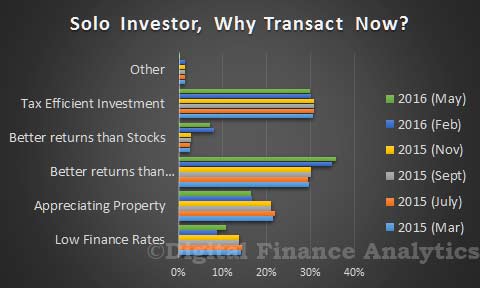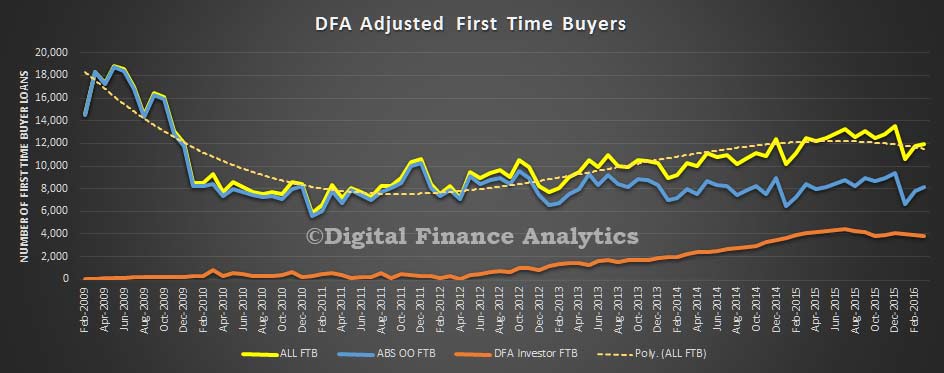AMP Bank has classified non-resident borrowers as an “unacceptable borrower type” amongst a myriad of other tougher lending rules regarding foreign income lending.
In the note sent to mortgage brokers last week, AMP said non-resident borrowers will now be deemed an unacceptable borrower type, unless a spouse or defacto is a citizen or permanent resident of Australia or New Zealand and a borrower of the loan.
In addition, the non-major has also cracked down on foreign lending income from nine currencies, in particular the Chinese Yuan.
The changes, applicable to any applications on or after Monday 30 May 2016, see only 50% of income derived from the Chinese Yuan (salary, investment and rental) as acceptable.
Where the Chinese Yuan is used for serviceability, the maximum LVR has also been reduced to 50%.
Eight other foreign currencies have also been subject to tightened conditions, albeit to a lesser extent than the Chinese Yuan.
Only 80% of the further eight currencies – Canadian Dollar, EURO, British Pound, Hong Kong Dollar, Japanese Yen, New Zealand Dollar, Singapore Dollar and U.S. Dollar – will be deemed acceptable. In addition, these currencies will also now have a reduced maximum LVR of 70%.
In the note sent to mortgage brokers, AMP said the restrictions came “due to recent changes in the market in relation to non-resident and foreign income lending”.
Tag: Mortgage Industry
Remuneration Review to Extend Beyond Brokers (But In Secret)
ASIC has evidently released the final scope of its review of remuneration in the mortgage broking industry – but only to industry insiders. According to media, the corporate regulator has confirmed it will review the remuneration arrangements of “all industry participants forming part of the value distribution chain”. This includes lending institutions, aggregation and broking entities, and associated mortgage businesses – such as comparison websites and market based lending websites – and referral and introducer businesses.
But why, we ask, was the scope not publicly disclosed? Why are ASIC seeking input only from industry participants? We agree the remuneration review is required – but the lack of transparency is a disgrace.
We asked ASIC about this and they replied:
At this point in time, ASIC has not published a media release commenting on the review or making the review available for download at this stage.
ASIC will usually put out a public statement, such as a media release or media advisory, on significant regulatory activities and outcomes, in order to:
- be transparent and accountable for what we do
- help inform our regulated population and the public of expected standards and of our priorities and areas of focus.
So they are happy with a private review evidently!
Worth also bearing in mind, the UK banned commission payments in the mortgage industry, which has moved to a fee for service model.
ASIC has released the final scope of its review into the mortgage broking industry, in which it confirms the review will extend far beyond mortgage brokers.
The final scope, released to the industry yesterday, sets out the parameters of the review. These were informed by input received from industry and consumer representatives through industry roundtables and subsequent written feedback. In it, the corporate regulator has confirmed it will review the remuneration arrangements of “all industry participants forming part of the value distribution chain”.
This includes lending institutions, aggregation and broking entities, and associated mortgage businesses – such as comparison websites and market based lending websites – and referral and introducer businesses.
ASIC also confirmed the review will extend to non-monetary benefits that relate to the distribution of residential loan products.
However, the review will not extend to loan products outside of residential mortgages, such as reverse mortgages or construction loans, which do not comprise a predominate proportion of the home lending mortgage market.
NAB has already come out in support of ASIC’s final scope.
“We believe ASIC’s scope is appropriate and we look forward to continuing to work with the regulator throughout the review,” Anthony Waldron, NAB EGM broker partnerships, said.
“We’re dedicated to working with brokers to deliver a great customer experience and we believe this review will help continue to build trust and confidence in the mortgage broking industry.”
So What’s On The Mind Of Property Investors?
Continuing the update of the latest household survey results, today we look at the investment housing sector. Having seen some months of reduced investment lending activity, the most recent ABS data showed a resurgence of investment lending. We think this will continue. As we reported yesterday, we recorded a spike in the proportion of households who were considering an investment property. Looking across all investors, they say it is the tax effective nature of the investment which drives the demand, coupled with appreciating property values. These together provides better returns than savings accounts or shares. The low costs of finance also helps.
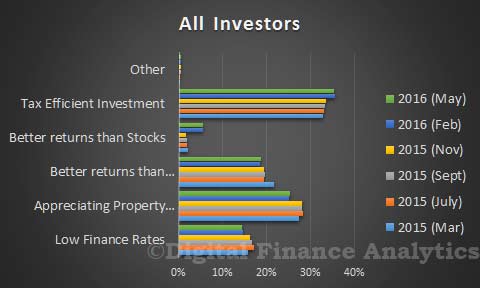 There are a number of barriers which might stop investors from transacting. Last time the prospect of potential budget changes registered, whereas this time the proportion of investor households who cited this as a reason to avoid transacting dissipated. We see a similar trend relating to changes in regulation. On the other hand, there was a rise in those unable to get funding – from below 5% last year to more than 15% this year, reflecting tighter underwriting requirement. So not everyone can get what they want. Results of the election are in the “Other” category, and hardly registered. Investors seem to assume no change in government. High home prices appear to be less of a barrier now.
There are a number of barriers which might stop investors from transacting. Last time the prospect of potential budget changes registered, whereas this time the proportion of investor households who cited this as a reason to avoid transacting dissipated. We see a similar trend relating to changes in regulation. On the other hand, there was a rise in those unable to get funding – from below 5% last year to more than 15% this year, reflecting tighter underwriting requirement. So not everyone can get what they want. Results of the election are in the “Other” category, and hardly registered. Investors seem to assume no change in government. High home prices appear to be less of a barrier now.
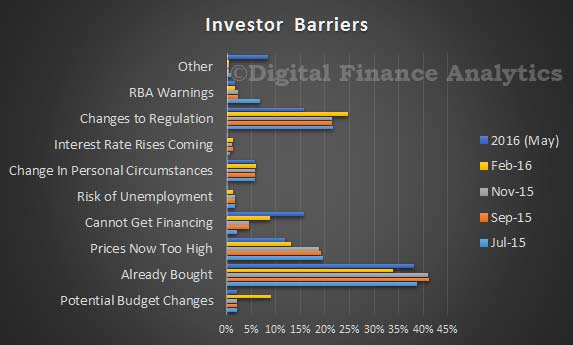 Looking at solo investors – those who only have one or two investment properties, the prospect of better returns than other investment vehicles is the strongest driver, and the recent cash rate cut has underscored this even more. We see evidence of older investors turning to property instead of bank term deposits (and we see a switch from term deposits to call savings accounts as part of the picture), because of the very low interest rates on offer.
Looking at solo investors – those who only have one or two investment properties, the prospect of better returns than other investment vehicles is the strongest driver, and the recent cash rate cut has underscored this even more. We see evidence of older investors turning to property instead of bank term deposits (and we see a switch from term deposits to call savings accounts as part of the picture), because of the very low interest rates on offer.
Households who are portfolio investors maintain a basket of investment properties. There are 193,000 households in this group (up by 2,000 from the previous survey). The median number of properties held by these households is eight. Some have more than 20!
In addition, we continue to see a rise in those investing via a SMSF (we have yet to detect an impact on the $1.6m cap which was announced in the budget, which of course is only applicable to those in draw down mode, and even then is still tax efficient).
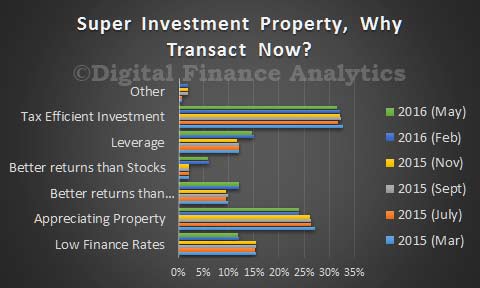 Households looking to invest via a SMSF seems to be getting information from a mortgage broker (24%) or internet sources (22%). Financial Planners (7%) lag behind Accountants (14%) and Real Estate Agents (11%).
Households looking to invest via a SMSF seems to be getting information from a mortgage broker (24%) or internet sources (22%). Financial Planners (7%) lag behind Accountants (14%) and Real Estate Agents (11%).
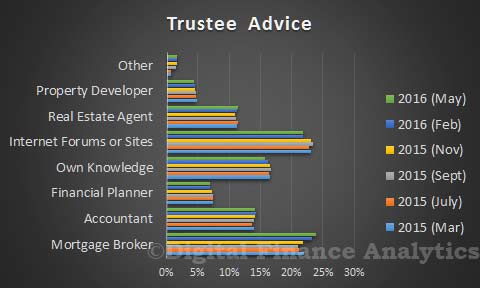 Finally, we still find that those who do investment via SMSF do not tend to put all their super savings into property.
Finally, we still find that those who do investment via SMSF do not tend to put all their super savings into property.
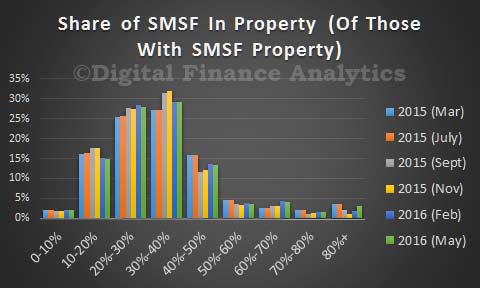 Next time we will look at the latest data relating to first time buyers.
Next time we will look at the latest data relating to first time buyers.
NAB enforces tougher foreign lending conditions
NAB has become the third major lender to announce tightened lending conditions for foreign buyers.
The new rules, which come into effect on 14 May, will see NAB only lend 60% of a property’s value to foreign buyers, down from 70% previously.
In addition, the major bank will recognise just 60% of foreign income sources, will no longer be accepting foreign sourced self-employed income, and will be tightening income verification requirements.
In a statement provided to Australian Broker, a NAB spokesperson said: “All foreign home loan applications are considered on a case by case basis and assessed under strict verification standards for employment and income, as well undertaking stringent risk processes.
“These settings are continually reviewed, and controls are tightened where necessary. NAB has limited appetite for this segment which comprises less than 2% of the NAB book.”
One mortgage broker, who asked to remain anonymous, also told the AFR that NAB would not be approving any loans to foreign buyers in “high-risk” areas.
These suburbs have yet to be identified, according to the AFR, but are expected to be inner-city areas in Melbourne and Sydney where there is a surplus of newly built apartments.
NAB’s decision follows announcements by Westpac and ANZ that they will be investigating mortgages backed by questionable foreign-income documentation, which forced them to stop approving such loans last month.
Bendigo and Adelaide Bank and Citigroup have also tightened lending conditions for foreign borrowers in the past week.
Investment Home Lending in March Stronger
The latest housing finance data from the ABS for March 2016 showed that looking at trend data, investment lending was stronger, up 1.1% whilst owner occupied lending fell 0.7% month on month. However, we know there was more than $1.5 bn of adjustments in March, so the data should be handled with care. Significantly, the proportion of loans being refinanced continued to grow, up to 34.3% by value.
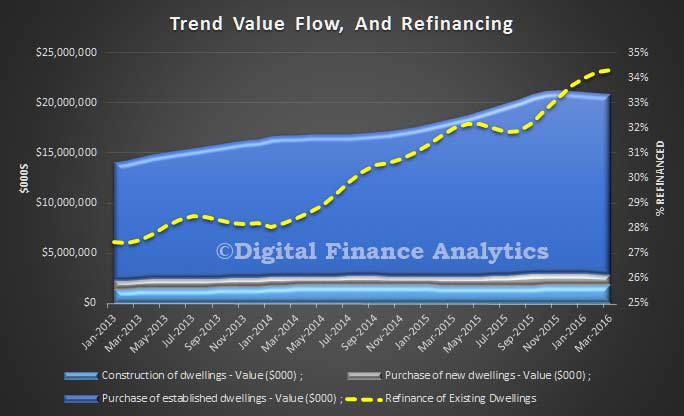 The percentage changes show significant falls in the purchase of new dwellings, down 5.8%, whilst refinance fell just 0.4% by value.
The percentage changes show significant falls in the purchase of new dwellings, down 5.8%, whilst refinance fell just 0.4% by value.
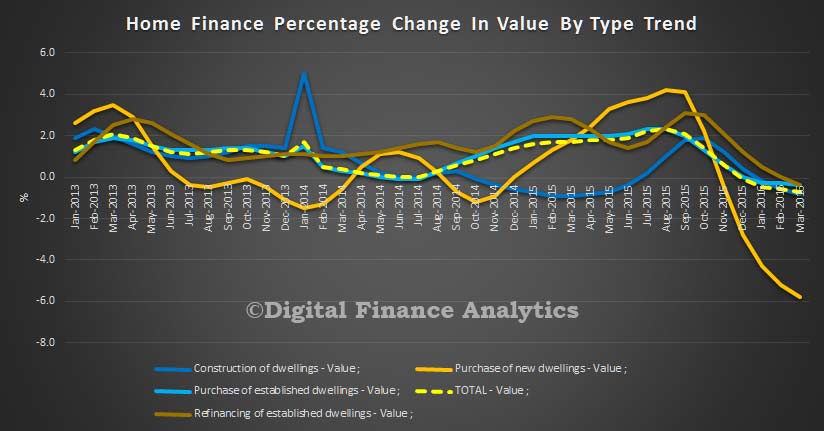 In trend terms, the number of commitments for owner occupied housing finance fell 0.2% in March 2016, whilst the number of commitments for the purchase of new dwellings fell 3.3%, the number of commitments for the construction of dwellings fell 0.9% and the number of commitments for the purchase of established dwellings rose 0.1%.
In trend terms, the number of commitments for owner occupied housing finance fell 0.2% in March 2016, whilst the number of commitments for the purchase of new dwellings fell 3.3%, the number of commitments for the construction of dwellings fell 0.9% and the number of commitments for the purchase of established dwellings rose 0.1%.
Looking at the mix of loans, the proportion of new loans for investment purposes rose from 35.7% to 36.1% in March.
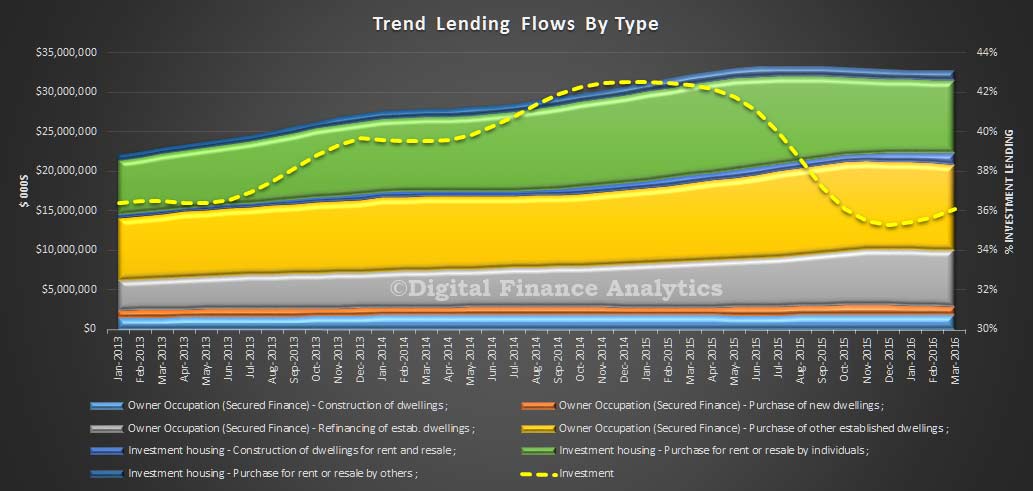 In stock terms, the proportion of investment loans fell slightly, from 35.8% to 35.7%. Owner occupied loan stock rose 0.71% to $953 billion, whilst investment loans grew 0.11% to $529 billion. Overall loan stock rose by 0.49% to $1,482 billion.
In stock terms, the proportion of investment loans fell slightly, from 35.8% to 35.7%. Owner occupied loan stock rose 0.71% to $953 billion, whilst investment loans grew 0.11% to $529 billion. Overall loan stock rose by 0.49% to $1,482 billion.
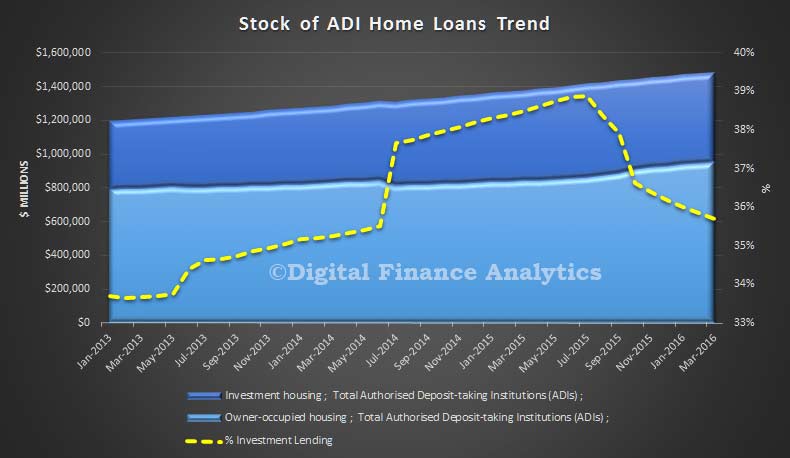 In original terms, the number of first home buyer commitments as a percentage of total owner occupied housing finance commitments fell to 14.2% in March 2016 from 14.6% in February 2016.
In original terms, the number of first home buyer commitments as a percentage of total owner occupied housing finance commitments fell to 14.2% in March 2016 from 14.6% in February 2016.
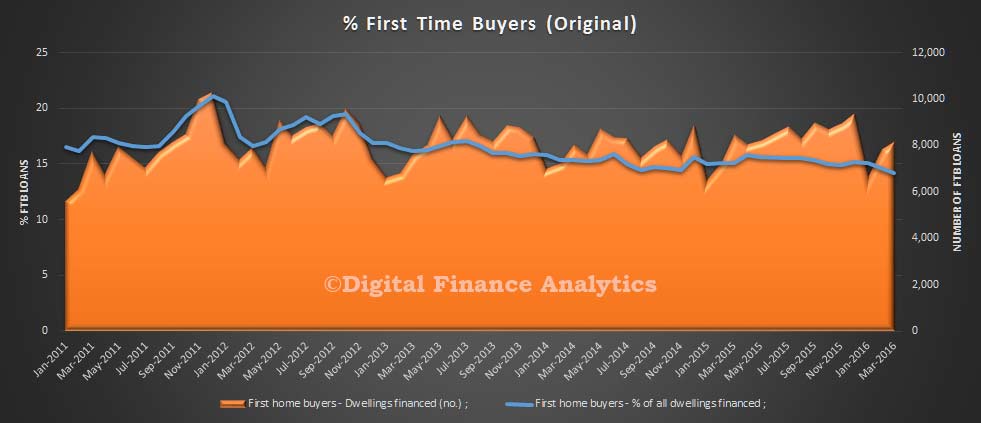 However, the number of loans rose by 4.1%, and the average loan loan size was $329k. We are still seeing a number of first time buyers going direct to the investor sector, through our household surveys, but the volumes were down by 2.8% in the month. Overall, there were 11,972 first time buyer transactions, up 1.8%; in original terms.
However, the number of loans rose by 4.1%, and the average loan loan size was $329k. We are still seeing a number of first time buyers going direct to the investor sector, through our household surveys, but the volumes were down by 2.8% in the month. Overall, there were 11,972 first time buyer transactions, up 1.8%; in original terms.
YBR Acquires SA Mortgage Business
Yellow Brick Road has announced an agreement to acquire South Australia-based mortgage manager, securing previously under represented territory. The purchase will increase scale and importance with key lenders, adds a new lender to YBR panel, and adds additional broker distribution via new third party aggregators. It extends on the ground product sales team beyond Sydney to Victoria and South Australia.
Yellow Brick Road Holdings Limited (ASX:YBR) (“YBR” or the “company”) announces that its wholly-owned subsidiary, Loan Avenue Holdings Pty Ltd, has today entered into an agreement to acquire the business and assets of privately-owned non-bank lender Loan Avenue Pty Ltd (“Loan Avenue”).
Loan Avenue will provide the national company a strong distribution footprint in South Australia, diversifying the mortgage book geographically and diluting reliance on Sydney and Melbourne mortgage markets.
Executive Chairman Mark Bouris said the acquisition of Loan Avenue, an established and profitable business, continues the company’s drive for scale.
“Loan Avenue is a respected B2B brand and has been in operation for ten years with a significant footprint, made up of more than 100 brokers in South Australia and Victoria. This acquisition allows us to quickly build more scale in South Australia, diversify and deepen our distribution network and funding relationships and increase our management capability,” Mr Bouris said.
“Paul and Michelle Collins have done an incredible job founding and building this company into one of South Australia’s top three non-bank lenders. They are highly regarded within South Australia by their funders and distributors and bring a wealth of experience to YBR.”
“Loan Avenue brings us some other talented product managers and credit experts with stronger delegated lending authorities, boosting our credit capacity. Importantly, this acquisition strengthens our relationship with existing funders and gives us access to an additional funder.”
Loan Avenue’s mortgage product compatibility with YBR’s own mortgage manager (YBR Group Lending, formerly RESI Mortgage Corporation acquired in FY2014) affords simple integration minus the complexity that often comes with a scale acquisition.
Loan Avenue founders and vendors Paul and Michelle Collins have agreed to stay on following the acquisition to assist in maintaining and driving existing aggregator and broker relationships as well as supporting integration.
Paul Collins said “We are delighted to join such a fast growing and diversified group as YBR. Our focus will be to enhance our broker relationships and drive further product initiatives with YBR, whilst maintaining the high service levels for which we are renowned.”
The maximum aggregate consideration agreed to be paid for Loan Avenue is $4.100 million, made up as follows:
- $2.6 million payable in cash on completion;
- The issue on completion of 2,596,153 fully paid ordinary shares in YBR (“YBR Shares”) at an agreed issue price of $0.26 each, representing $0.675 million in value;
- Deferred cash consideration of $0.450 million, payable in 3 instalments over the first 12 months after completion; and
- Subject to satisfying certain earn-out conditions during the period ending on the first anniversary of completion, an additional amount of up to $0.300 million in cash and up to $0.075 million in YBR Shares (to be issued at the same agreed issue price of $0.26 each), payable as soon as Loan Avenue’s relevant performance against the earn-out conditions is agreed or determined.
All YBR Shares to be issued will be subject to a voluntary 12 months’ escrow period from the dates of their issue. No shareholder approval is required for the issue of the YBR Shares.
The acquisition of Loan Avenue remains subject to a number of conditions precedent and, assuming the conditions are satisfied, completion of the acquisition is expected to occur on 31 May 2016.
The cash components of the acquisition will be funded out of the company’s existing cash reserves and undrawn portions of its CBA facility.
More Australian Banks Throttle Back Foreign Lending
More Australian lenders have taken a hard-line approach to foreign lending, stopping lending to foreign borrowers or excluding foreign-sourced income from mortgage applications amid growing concerns about fraud.
Citigroup wrote to mortgage brokers yesterday with a blacklist of foreign currencies it will no longer accept as payment for Australian real estate from overseas borrowers, the Australian Financial Review (AFR) reported.
The letter, sent by Citi’s head of mortgage distribution, Matt Wood, contained a list of 12 currencies that it will accept and warned that all others are “not negotiable”.
In a statement provided to Australian Broker, a spokesperson for Citi confirmed at least five currencies have been excluded from mortgage applications.
“We want to continue to ensure we have a robust and healthy residential loan book catering to foreign buyers. In light of recent industry concerns regarding foreign residential loan applications relying on offshore income we have excluded certain currencies to ensure we don’t attract any increases in unwanted loan applications.
“These currencies include the Chinese RMB, Indian Rupee (INR), Indonesian Rupiah (IDR), Malaysian Ringit (MYR) and Taiwan Dollar (TWD).”
Citi’s decision comes after Westpac and ANZ announced they will be investigating mortgages that have been backed by questionable foreign-income documentation, which forced them to stop approving such loans last month.
Bendigo and Adelaide Bank has also since warned its network of brokers to halt lending to foreign borrowers and exclude foreign-sourced income. In a statement provided to Australian Broker, a spokesperson said the non-major has received a “marked increase” in foreign applications.
“Bendigo and Adelaide Bank has always had a policy which allowed funding of expat Australian borrowers and, in certain circumstances foreigners to purchase property in Australia.
“This financial year, in the eight months to end of February 2016, this amounted to new lending advanced of less than $60m.
“In March and April following policy adjustments at other banks, we have seen a marked increase in enquiry and applications, exceeding our risk appetite. As a result we are reviewing our current position in the market.”
The chief executive of Mortgage Choice, John Flavell, told Australian Broker he expects more lenders to announce similar bans or restrictions.
“Given the recent developments, I am not surprised to see many of Australia’s lenders taking a hard line approach to foreign income lending.
“These policy changes will make it harder for foreign investors to purchase property in Australia using foreign income. Over the coming days and weeks, I expect to see more lenders tightening their policy in this area.”
Bendigo Pockets Some Of The Rate Cut
Bendigo Bank has announced it will decrease its residential variable interest rate by 0.20% p.a. to 5.48% p.a.
The Bank has also reduced the Bendigo investment variable rate by 0.15% p.a. to 5.76% p.a.
Bendigo and Adelaide Bank Managing Director Mike Hirst said the adjustment aims to find a fair balance for all of the Bank’s key stakeholders.
“When setting interest rates our Bank needs to consider many factors and carefully take into account the needs of our stakeholders including borrowers and depositors, shareholders, staff, partners and the broader community,” Mr Hirst said.
These historically low interest rates will also impact deposit holders. Mr Hirst noted the challenges the decrease will generate for those looking to earn money through investment in deposits.
“These customers remain front of mind for our Bank, and the rate reduction announced today seeks to strike the right balance between the needs of borrowers and depositors,” he said.
Customers on a residential variable interest rate with a $400,000 loan will see their repayments decrease by $50 a month (principal and interest home loan over 30 years).
The adjustment is effective 30 May 2016 for new and existing loans.
ANZ and Westpac Report Chinese Home Loan Fraud
The AFR is reporting that hundreds of home loans have been backed by fraudulent Chinese income documents, with the help of dodgy mortgage brokers. The banks have informed the police, suspended the brokers concerned, and have changed their review processes.
The banks also make the point that delinquencies are lower on the small proportion of the book which is foreign investor related. The AFR suggests total loans involved are less than $1 billion.
You can hear our comments on the ABC Radio PM Programme.
Recently some banks have stopped lending to foreign investors. This includes Westpac.
This comes on the back of recent media comments on fraudulent changes being made to mortgage applications, and the ASIC review of broker practices and commissions. ASIC recently highlighted one case of broker fraud.
Given that around half of all mortgages are originated via the broker channel, it is no surprise there is focus on brokers conduct. Our recent post on mortgage brokers discusses this in detail.
ABC Four Corners Does The Housing Boom
Last night the ABC aired a programme on the housing boom. It focused on the impact property investors are having on driving home prices higher and making access to property ever more difficult for owner occupied purchasers who are trying to enter the market. Whilst there was little that was new to followers of this blog, one segment looking at the high rate of vacant units in the Melbourne high-rise developments was striking.
Also, there was evidence of applications being “tweaked” to make incomes higher, such that a loan would pass underwriting muster. Some are suggesting this is a prevalent practice, and links to poor bank culture.
You can read the transcript across at the ABC site, and watch the programme (if you are not Geo-blocked).
Here is the segment on Melbourne’s ghost apartments.
I think the missing element for me was the fact that this is an intentional strategy, led by the Reserve Bank to make housing, and households do the heavy lifting as the mining boom fades. No surprise then that loan to income ratios are off.
The long term implications of this policy have yet to come home to roost.

